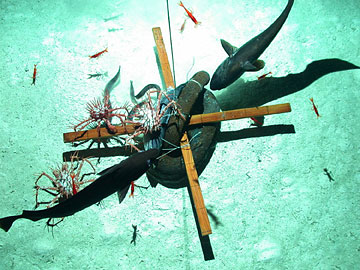 COURTESY NOAA A bait station planted by researchers aboard the research vessel Hi'ialakai draws a crowd. Among the creatures that gather more than two miles deep in the waters off the Northwestern Hawaiian Islands are bighead grenadier, snub-nosed eel, king crabs and fine-scale codling. CLICK FOR LARGE |
|
Diversity lives deep at sea monument
When researchers lowered a camera two miles deep into the waters of the Papahanaumokuakea Marine National Monument, they weren't sure what they'd see.
Nobody had ever looked that deep before.
During a three-week cruise last month, they saw Pacific sleeper sharks, a species normally seen in shallower water off Alaska; giant hagfish, a species previously believed rare; and big-head rattail fish, which have heads like cod and bodies like eels.
Twelve other fish species and 13 species of crabs, shrimps and other crustaceans were also seen in the deep ocean off Pearl and Hermes Atoll and Lisianki, Laysan and Nihoa islands.
"It's an amazingly diverse community," said Jeff Drazen, the University of Hawaii assistant oceanography professor in charge of the deep-water camera that was deployed from the National Oceanic and Atmospheric Administration's research ship Hi'ialakai.
The sighting of a Pacific sleeper shark was the first at that depth and in the Northwestern Hawaiian Islands, Drazen said. The nearest sighting of the species in Hawaii was about two-thirds of a mile deep, offshore from Oahu, he said.
The sharks are much more commonly seen off the coasts of California and Japan. They reach lengths of up to 16 feet, have 3-foot-wide mouths and are believed to include stellar sea lions in their diet, Drazen said.
Using skipjack tuna for bait and an underwater flash, the camera got photos of a variety of creatures that dwell in waters 1,700 feet to 2.5 miles deep. That vast, dark zone of the ocean is "less explored than the moon," Drazen said.
Looking in deep water was just one new aspect of the monument explored during the recent voyage, said Randy Kosaki, NOAA chief scientist.
Another new project was collection of coralline algae -- the calcium-rich algae that actually forms much of the reef, especially in the colder Northwestern Hawaiian Islands.
Cheryl Squair and Kate Cullison, both of the UH Botany Department, collected a couple of 10-gallon pails full of the crispy algae, which has not been systematically collected in Hawaii before now, Squair said.
Though identifying coralline algae in the field is difficult, she believes up to 40 species could be represented, Squair said.
Understanding coralline algae is important because it is susceptible to higher acid content in sea water that is caused by global warming, Kosaki said.
Other projects on the voyage included:
» Checking the accuracy of satellite mapping of sea floor types.
» Collecting data about the movements of radio-tagged sharks, ulua and other large predator fish.
» Continuing a project to determine how closely members of the same species living on different islands of the entire Hawaiian Archipelago are related to each other. For example, some hermit crabs that inhabit the northernmost islands appear to be more closely related to hermit crabs on Nihoa, which is near Kauai, than to crabs living on islands further up the chain, said Scott Godwin, a UH Institute of Marine Biology researcher.

